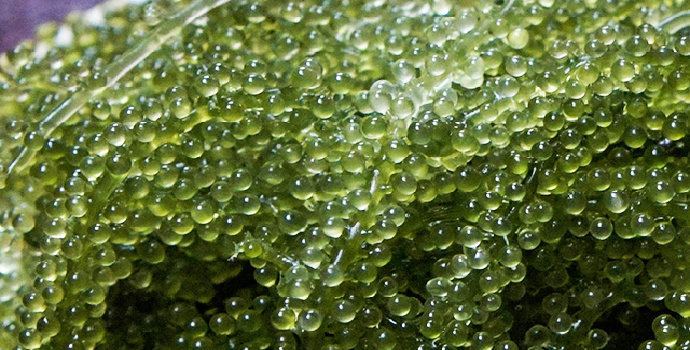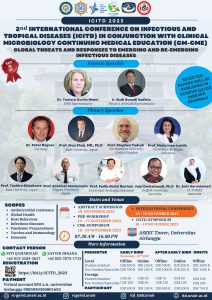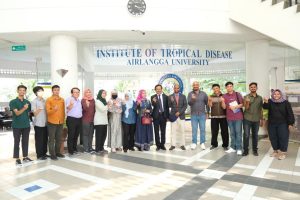{:en}The Coronavirus Disease (COVID-19), caused by the novel coronavirus was detected in December 2019 in Wuhan, China for the first time and quickly spread into a global pandemic. This study aims to predict the potential of macroalgae bioactive compounds as SARS-CoV-2 antivirals by inhibiting the ACE2 receptor through an in silico approach. Twenty-seven macroalgal compounds were obtained from PubChem (NCBI, USA), while the target protein ACE2 receptor was collected from the Protein Data Bank (PDB). Then the drug similarity screening was carried out using Lipinski’s rules from five web servers and prediction of bioactive compounds was carried out using PASS (predicted activity spectrum for biologically active substances) via an online web server.
After the compound was approved by Lipinski’s five rule and PASS online prediction web server, blind docking simulations were performed with PyRx 0.8 software to show the binding energy values. Molecular interaction analysis was performed with BIOVIA Discovery Studio 2016 v16.1.0 and PyMOL v2.4.1 software. There are six macroalgae compounds approved by Lipinski rules and PASS Analysis Online. The result was that the macroalgae siphonaxanthin among 27 macroalgae compounds showed a strong binding energy to bind to the ACE2 receptor with a value of -8.8 kcal/mol. This study also used SARS-CoV-2 drugs as positive controls, namely remdesivir, molnupiravir, baricitinib, lopinavir, oseltamivir, and favipiravir. The results showed that siphonaxanthin had the lowest binding energy compared to common drugs SARS-CoV-2. Macroalgae compounds are predicted to have potential as SARS-CoV-2 antivirals. Thus, further studies need to be investigated with in vitro and in vivo analyzes to confirm the inhibitory activity of siphonaxanthin against SARS-CoV-2.
Authors: Teguh Hari Sucipto, Hasriaton Padmi, Rahadian Zainul et al.
Article Title: Macroalgae Bioactive Compounds for the Potential Antiviral of SARS-CoV-2: An In Silico Study
Detailed information about this scientific article can be found at: https://microbiologyjournal.org/macroalgae-bioactive-compounds-for-the-potential-antiviral-of-sars-cov-2-an-in-silico-study/
Source : unair.ac.id
Picture Source : Dictio Community{:}{:id}Penyakit Coronavirus (COVID-19), yang disebabkan oleh novel coronavirus terdeteksi pada Desember 2019 di Wuhan, China untuk pertama kalinya dan menyebar dengan cepat menjadi pandemi global. Kajian ini bertujuan untuk memprediksi potensi senyawa bioaktif makroalga sebagai antivirus SARS-CoV-2 dengan menghambat reseptor ACE2 melalui pendekatan in silico. Dua puluh tujuh senyawa makroalga diperoleh dari PubChem (NCBI, USA), sedangkan reseptor ACE2 protein target dikumpulkan dari Protein Data Bank (PDB). Kemudian skrining kemiripan obat dilakukan dengan aturan Lipinski dari lima server web dan prediksi senyawa bioaktif dilakukan dengan PASS (Prediksi spektrum aktivitas untuk zat aktif biologis) melalui online server web.
Setelah senyawa tersebut disetujui oleh aturan lima Lipinski dan PASS online server web prediksi, simulasi blind docking dilakukan dengan perangkat lunak PyRx 0.8 untuk menunjukkan nilai energi ikat. Analisis interaksi molekuler dilakukan dengan BIOVIA Discovery Studio 2016 v16.1.0 dan perangkat lunak PyMOL v2.4.1. Ada enam senyawa makroalga yang disetujui oleh aturan Lipinski dan Analisis PASS Online. Hasilnya adalah senyawa makroalga siphonaxanthin di antara 27 senyawa makroalga menunjukkan energi ikat yang kuat untuk mengikat reseptor ACE2 dengan nilai -8,8 kkal/mol. Penelitian ini juga menggunakan obat SARS-CoV-2 sebagai kontrol positif yaitu remdesivir, molnupiravir, baricitinib, lopinavir, oseltamivir, dan favipiravir. Hasil penelitian menunjukkan bahwa siphonaxanthin memiliki energi ikat paling rendah dibandingkan dengan obat umum SARS-CoV-2. Senyawa makroalga diprediksi berpotensi sebagai SARS-CoV-2 antivirus. Dengan demikian, studi selanjutnya perlu diselidiki dengan analisis in vitro dan in vivo untuk konfirmasi aktivitas penghambatan siphonaxanthin terhadap SARS-CoV-2.
Penulis: Teguh Hari Sucipto, Hasriaton Padmi, Rahadian Zainul dkk.
Judul Artikel: Macroalgae Bioactive Compounds for the Potential Antiviral of SARS-CoV-2: An In Silico Study
Informasi detail tentang artikel ilmiah ini dapat dilihat di: https://microbiologyjournal.org/macroalgae-bioactive-compounds-for-the-potential-antiviral-of-sars-cov-2-an-in-silico-study/
Sumber : unair.ac.id
Sumber Gambar: Dictio Community{:}





